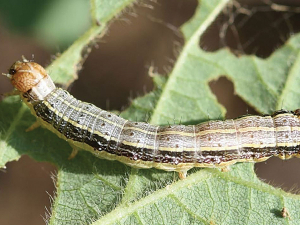Biosecurity progress and challenges for NZ winegrowers
Dr Ed Massey is General Manager Sustainability at New Zealand Winegrowers.
 Fall armyworm is believed to have blown over to New Zealand from Australia after a cyclone in early 2022.
Fall armyworm is believed to have blown over to New Zealand from Australia after a cyclone in early 2022.
The Ministry for Primary Industries (MPI) is investing in the development of an integrated pest management approach to safeguard New Zealand’s maize and sweetcorn industries against fall armyworm.
MPI will contribute up to $300,000 over three years to the $630,000 project through the Sustainable Food and Fibre Futures fund.
“We’re collaborating with the Foundation for Arable Research, Process Vegetables NZ, Vegetables NZ Inc, and growers on management and mitigation strategies to help reduce production losses and enhance resilience to this invasive pest,” says Biosecurity New Zealand deputy director-general Stuart Anderson.
“Together we’ll develop some really good tools for growers, including establishing surveillance networks on a national scale.”
Fall armyworm is believed to have blown over to New Zealand from Australia after a cyclone in early 2022. After a year of battling the pest, MPI and industry partners agreed to close the response and shift the focus to longterm management of the pest by industry. Fall armyworm has the potential to impact 72,490 hectares of maize, with an estimated value of more than $480 million and 3320 hectares of sweetcorn production, with an export value of $36.9 million.
“We don’t know what the full impact of the fall armyworm incursion will be in the future as it depends largely on our winter temperatures and suitable host plants in the absence of maize and sweetcorn,” says Ashley Mills, biosecurity officer, Foundation for Arable Research (FAR).
“For instance, in areas with warmer winter temperatures such as Northland, the insect has the capacity to overwinter and survive all year round. With warming temperatures, we might expect the problem to grow year on year.
“Part of our research will be to identify gaps of knowledge around the winter growing season and dispersal of fall armyworm.
“We’ll produce models and come up with early warning tools for agronomists and growers, so they understand when they need to employ their most intensive management strategies.
“There’s no one-sizefits- all solution, and approaches may vary according to factors such as region, climate or soil type. In most cases, encouraging beneficial insects will work, but in more problematic regions or localities, insecticides might be needed, and the timing of application will be important.
“Over the next 3 years we’ll focus on understanding fall armyworm phenology and distribution, developing New Zealand specific economic thresholds and finding long-term solutions that reduce reliance on agrichemicals, and preserve soil health, water quality and biodiversity.”
FAR and Vegetables NZ Inc will host information and tools for fall armyworm management on their websites. This will include modelling, distribution maps, guidelines, and training videos. FAR will also host workshops over winter, tailored to each region.
Anderson says engagement with growers will be an essential part of the programme.
“Ultimately, it’s the growers that will need to implement the strategies and use the tools. This project aims to make these easily available for everyone to use.”
Farmer confidence has taken a slight dip according to the final Rabobank rural confidence survey for the year.
Former Agriculture Minister and Otaki farmer Nathan Guy has been appointed New Zealand’s Special Agricultural Trade Envoy (SATE).
Alliance Group has commissioned a new heat pump system at its Mataura processing plant in Southland.
Fonterra has slashed another 50c off its milk price forecast as global milk flows shows no sign of easing.
Meat processors are hopeful that the additional 15% tariff on lamb exports to the US will also come off.
Fears of a serious early drought in Hawke’s Bay have been allayed – for the moment at least.

OPINION: The release of the Natural Environment Bill and Planning Bill to replace the Resource Management Act is a red-letter day…
OPINION: Federated Farmers has launched a new campaign, swapping ‘The Twelve Days of Christmas’ for ‘The Twelve Pests of Christmas’ to…